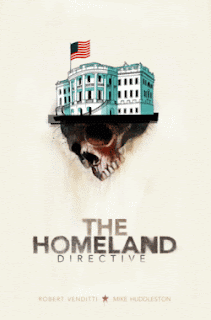Written by Robert Venditti
Art by Mike Huddleston
Published by Top Shelf
Is the conspiracy thriller a very common genre in comics? Probably not, at least in the United States branch of the medium, so it's nice to see something a bit different from the norm, a sort of mainstream action-movie style of story, playing on the current era of heightened security and invisibly invasive lack of privacy to generate a feeling of paranoia and make a bit of a political point about the accountability of those in positions of power. It's a pretty smart, plausible story, seeing a fanatical Director of Homeland Security kicking off a complicated scheme intended to strengthen American security by murdering a large number of its citizens, with a doctor for the Centers for Disease Control suddenly caught in the middle of the plot and trying to survive a sudden target on her back, but somehow still bring down the bad guys with the assistance of a trio of men from the FBI, the Secret Service, and the Bureau of Consumer Advocacy (the most dangerous government branch of all, apparently) who caught wind of what was happening and decided to team up to stop it, barely understanding its full scope themselves. It all ends up as a book-length series of tense conversations and confrontations, leading to an expected resolution that restores the status quo, while hinting that there may be some merit to the villain's schemes, a realization that the vast amount of information that exists for everyone makes those in power walk a fine line between privacy and security, ever-cognizant of the ethics behind their actions, since a momentary slip in the sense of what is and isn't allowable in the name of "protecting the country" can lead to disaster.
On the story level, the book works rather well, if it does end up with a bit more talk and a bit less action than a cinematic adaptation would probably feature. This might be an attempt at a movie deal (which writer Robert Venditti, who also penned The Surrogates, has experience with), but luckily, Mike Huddleston is too good of an artist to slap something generic onto the page in hopes of Hollywood lucre. He infuses the book with a sense of gritty realism, wonderfully delineating characters' expressions and body language with his brushy linework during the many dialogue scenes, and differentiating what could have been interchangeable Federal agents well, while realistically capturing Dr. Regan's confusion and fear as her life is suddenly turned upside down. Huddleston could probably make scene after scene of people talking lively and exciting using simple black and white art, but his color work here is especially exceptional, often sticking to a limited palette, but regularly shifting into expressive hues that add to scenes' mood excellently, and bursting into boldly eye-catching colors in scenes of action or violence. Or just when the tenor of a scene requires; when Regan is speaking at a conference just before being targeted, she is surrounded by garishly bright reds, blues, yellows, and oranges:
A scene in which she sits in a hotel room discussing her plight with the agents is more understated, but an intricate wallpaper design hangs in the background, emphasizing her disorientation:
It's an especially effective demonstration of a technique that seems to be gaining in popularity in comics these days (see also: Xombi, illustrated by Frazier Irving), with pages and individual panels often marked by a particular color scheme dependent on characters and locations, lending an immediately recognizable tone to each scene upon first glance:

In another great demonstration of artistic versatility, whenever the villainous Homeland Security Chief meets with the President (a faceless, unnamed version of Barack Obama), deep, moody shadows suddenly add layers of moral murkiness:

It's lovely work all around, although it starts to seem a bit rushed near the end of the book, as more and more backgrounds are composed of cut-out and pasted-together images of buildings:

This wouldn't be an issue, but its repetition, along with the obviousness of its artificiality, makes it stand out. But next to everything else surrounding it, it's hardly a dealbreaker.
As nice-looking as the book is (and it's really, really nice, some of the best coloring on a graphic novel this year), it doesn't quite rise above the level of escapist entertainment, even though it does feature something of a message. It's fast-moving, with a sense of danger and excitement, but never a full-on, white-knuckle, can't-put-it-down grip on the reader. It will probably make for a completely decent movie starring Naomi Watts or Nicole Kidman someday, but nothing that will inspire lines in front of theaters or multiple Oscar nominations. That's fine; moms and dads need something to read/watch too.




interesting post :)
ReplyDelete